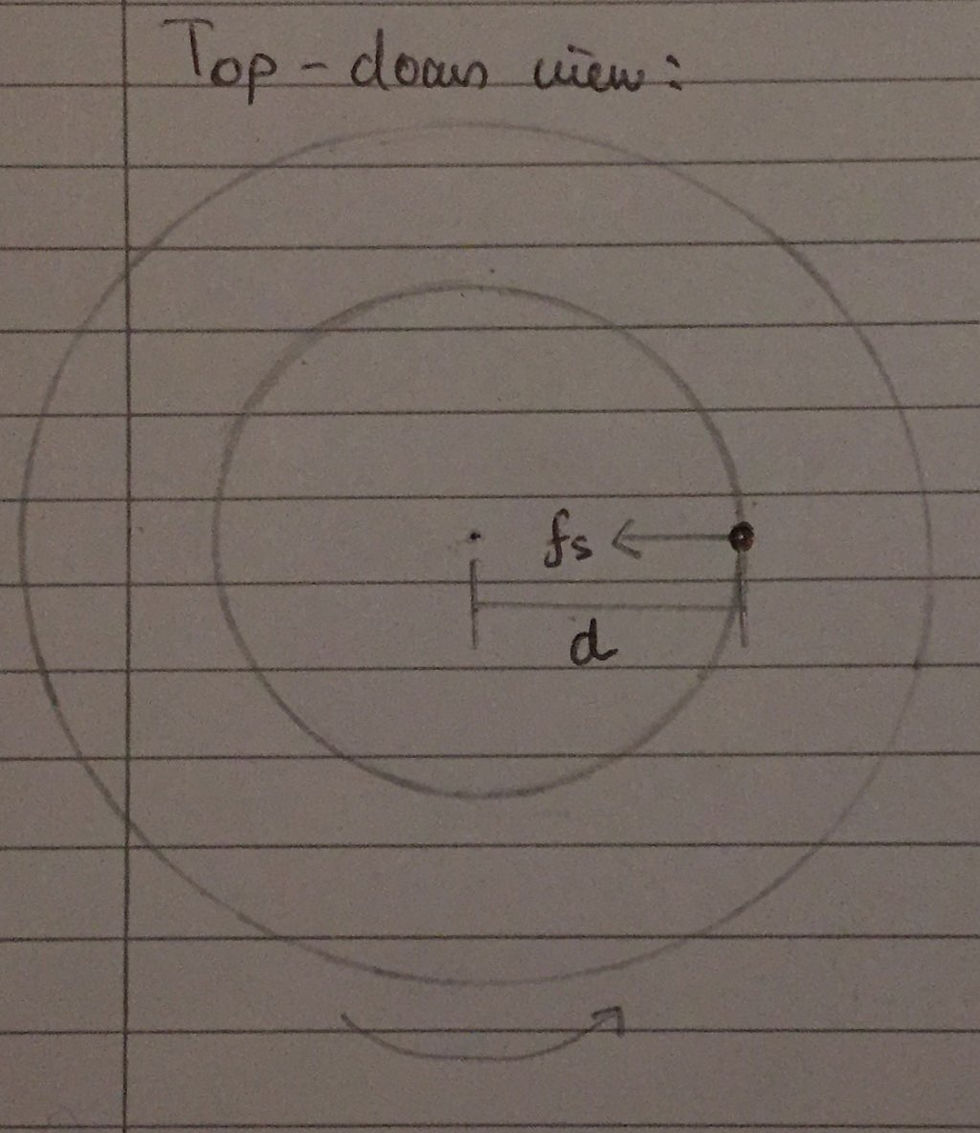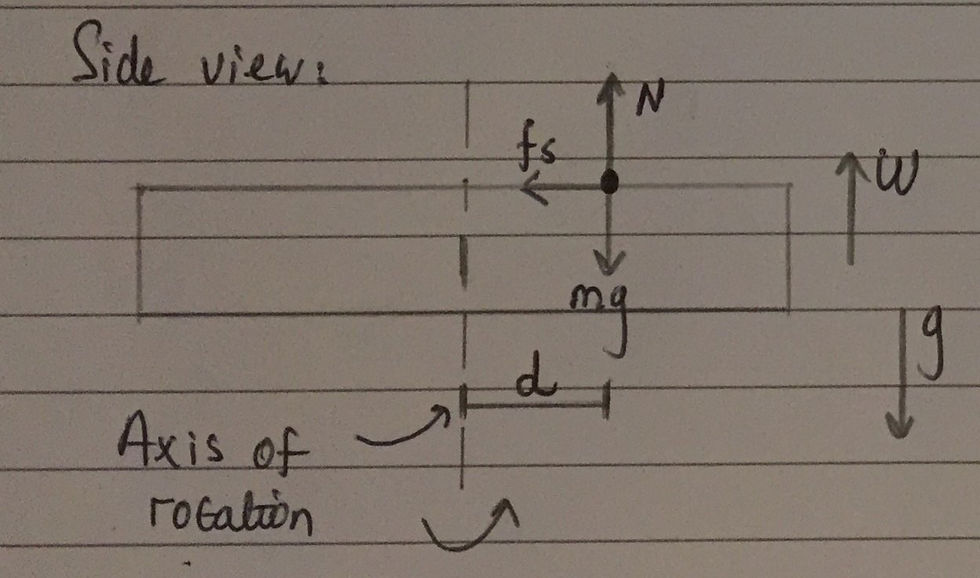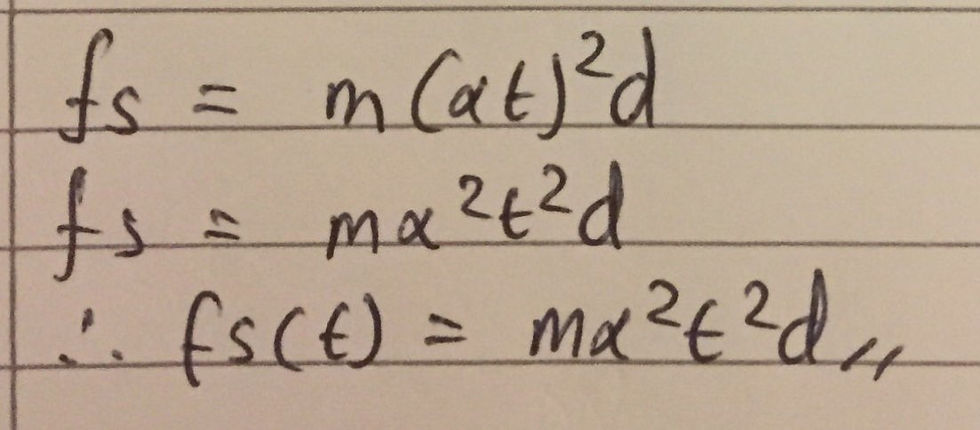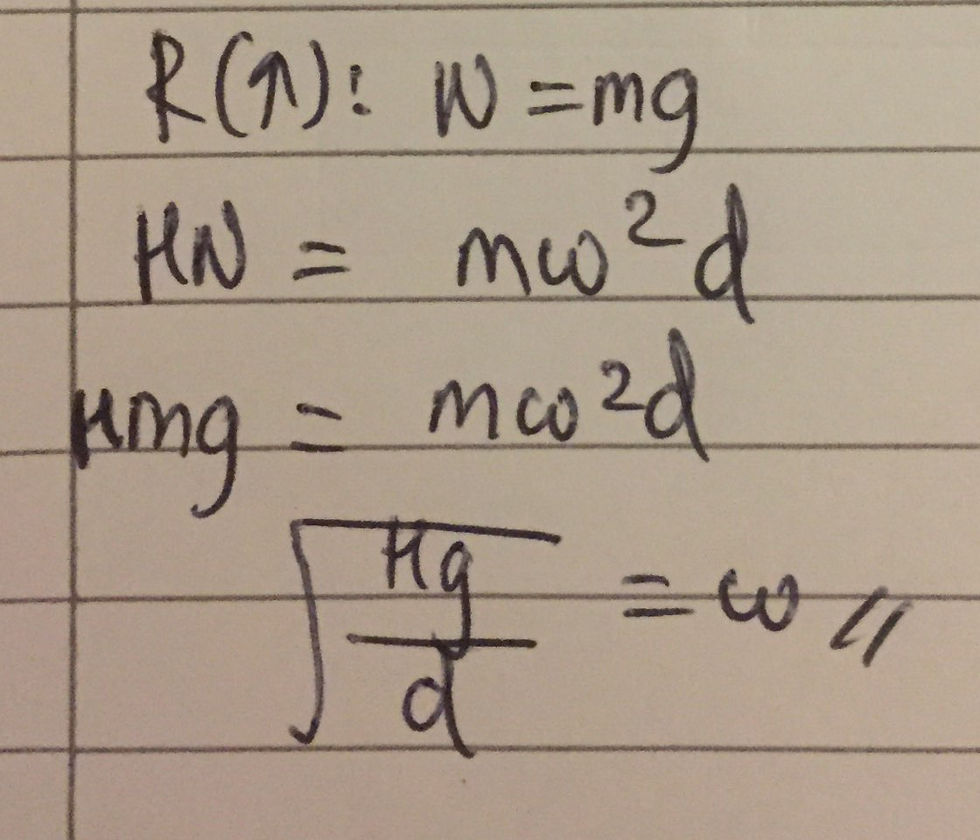MIT Problem Set 3 - Circular Motion Question 6
- Joel Runevic

- Aug 9, 2019
- 3 min read
Updated: Oct 19, 2020
Question 6: A coin on a rotating disk

Image sourced: https://ocw.mit.edu/courses/physics/8-01sc-classical-mechanics-fall-2016/assignments/MIT8_01F16_pset3.pdf
Theoretical analysis:

This question consists of a coin, with mass m, that is placed on a rigid disk. The coin is placed at a distance d from the centre of the disk, which is the radius of the coin's circular path. As specified in the question, there exists static friction between the coin and the disk, which I have labelled as Fs. Considering the problem from a top-down view, we can see that the only horizontal force acting on the coin is the static frictional force between the coin and the disk, labelled as Fs. This will therefore provide the centripetal force that acts on the coin, keeping it in circular motion, rotating anticlockwise relative to the centre of the disk, at a distance d away from it. I have included the top-down free body diagram above.

Considering the side view, we can yet again see that the static frictional force, Fs, is acting towards the centre of the disk and is the only horizontal force acting on the coin. In the vertical direction, the normal contact force between the coin and the disk, labelled as N, is equal to the weight of the coin, mg. I have included the side view free body diagram above.
Part A:
As aforementioned, the static frictional force, Fs, between the coin and the disk will provide the centripetal force which will ultimately keep the disk revolving around the centre of the disk for a certain period of time. We can therefore state that m*ω^2*d = Fs (1). The disk begins from rest, when t = 0, and, unlike previous circular motion problems that we have encountered in this problem set, it begins to rotate with a constant angular acceleration, indicated as α. This means that the coin will not rotate with a constant angular velocity, ω, but rather its radial velocity will increase as time increases. We know that angular acceleration, α, is defined as the rate of change of the angular velocity, ω, of a body with respect to time, t. In mathematical terms, dω/dt = α.
Thus by simple manipulation, we can state that dω = α dt. This allows us to integrate both sides, resulting in the following equation - ω = u + αt, where u is the initial angular velocity of the coin. The value of u in this case is zero as we are implicitly told that the disk rotates from rest. We can thus state that ω = αt (2). This is essentially the rotational equivalent of the translational equation of motion that is v = u + at. This can simply be memorised and used when necessary, however I believe it was beneficial to derive it in order to develop a greater appreciation of the mathematics behind the equations of rotational mechanics. I have included my workings in a diagram below:

In order to find the magnitude of the force of static friction between the disk and the coin as a function of time, Fs(t), we have to substitute equation (2) into equation (1) as I have done so in my calculations below:

Part B:
As the angular velocity, ω, of the coin increases as time increases, so will the magnitude of the centripetal force that is required to keep the coin in circular motion. The centripetal force on the coin is provided entirely by the static frictional force, Fs, which is exerted by the disk on the coin. However, the static frictional force has a maximum value which is equal to μN, where μ is the coefficient of static friction between two surfaces - the coin and the disk in this case. Therefore, the coin will be on the point of slipping when the centripetal force acting on the coin is equal to the maximum static frictional force that can be exerted by the disk on the coin. In other words, m*ω^2*d = μN (1). We are not permitted to use N in our final answer. Resolving forces vertically, however, it is clear that N = mg (2). We can substitute equation (2) into equation (1). One now simply has to rearrange for ω, giving the final answer. I have included my final workings in a diagram below:

That is it for question six. If you have any questions about the problem, feel free to email us on the Contact Us page. That is the end of the solutions for Problem Set 3. I have very much enjoyed solving these problems and sharing my solutions with you all. If you would like me to solve any other problem sets, please comment down below.



Thanks for the response. The two links you referenced are interesting but don't get to my concern because they don't explicitly deal with the vector decomposition issue. Poking around more, however, I found the following video, which deals with the tangential acceleration point around time 3:10:
https://www.youtube.com/watch?v=NykZcuRtM3c
This jibes with my intuition that the static force analysis in a angular acceleration scenario needs to account for both radial and tangential components -- i.e., the magnitude of both accelerations (viz., the square root of the sum of the squares of the radial and tangential accelerations).
I think perhaps the worked solution provided above is actually addressing a slightly different fact pattern, one in which the turntable is NOT undergoing constant angular…
Hey @JP
I think I understand what you are trying to say, and, in all honesty, I had the same thoughts. I used the following two videos to better understand this question and the concepts behind it:
https://www.youtube.com/watch?v=WdcfWf07UIg
https://www.youtube.com/watch?v=NR4KV_IG0jc
The first video, in particular, deals with a turntable that has increasing acceleration.
I hope this is useful. If not, please do let me know if you have any more questions.
Thanks,
Joel
I follow / understand the analysis as presented, which jibes with my work on the problem looking at the perpendicular (k^) and radial (r^) vectors. But where I ran into trouble was how (and whether) to deal with the tangential (theta^) vector.
If the disk were spinning at a uniform angular velocity (viz., with zero angular acceleration), then I get that the only friction force and acceleration experienced by the coin are radial (r^). But since the disk is undergoing a non-zero angular acceleration, that means that the coin is also experiencing a tangential (theta^) friction force and acceleration. As a result, I was anticipating that the analysis would have to decompose the total max friction (uN) into radial a…